Volunteer Fire Chief Dies From Injuries Sustained During a Tanker Rollover - Utah
 Death in the Line of Duty...A summary of a NIOSH fire fighter fatality investigation
Death in the Line of Duty...A summary of a NIOSH fire fighter fatality investigation
F2005-27 Date Released: July 24, 2006
SUMMARY
On June 21, 2005, a 52-year-old male volunteer Chief died from injuries sustained during a tanker rollover. The Chief was driving a military surplus truck that had been converted into a tanker. He was traveling to a nearby town to obtain a State inspection. While driving on the gravel road at approximately 40 miles per hour, the left front tire ruptured causing him to lose control, leave the road, and roll over several times. The Chief was ejected and died on the scene from his injuries. NIOSH investigators concluded that, to minimize the risk of similar occurrences, fire departments should:
- develop and enforce standard operating procedures (SOPs) for seat belt use
- determine a safe operating weight for water tankers based on vehicle characteristics and remove overweight vehicles from service
Additionally, States should
- develop an inspection program to identify and correct defects and deficiencies in government surplus vehicles prior to being released to the fire service

|
|
Photo courtesy of State forestry department.
|
INTRODUCTION
On June 21, 2005, a 52-year-old male volunteer Chief died from injuries sustained during a tanker rollover. On June 24, 2005, the U.S. Fire Administration (USFA) notified the National Institute for Occupational Safety and Health (NIOSH) of the fatality. On August 21-25, 2005, two Safety and Occupational Health Specialists from the NIOSH Division of Safety Research investigated the incident. Meetings were held with the State training academy, State forestry department, and County Sheriff’s office. Interviews were conducted with representatives from the State forestry department, the County Sheriff’s Office, and an officer of the fire department. The NIOSH investigators reviewed the County Sheriff’s report, State forestry department Federal Excess Property Program Records (FEPP), the victim’s training records, and photographs and drawings of the incident site. The incident site was visited and photographed.
Department
The volunteer department involved in this incident was comprised of 20 volunteer fire fighters who operated out of three stations. The department serves a population of approximately 400 residents in a geographic area of about 320 square miles.
Training
The State of Utah does not require a commercial driver’s license or any specialized training for its fire fighters. However, the victim had received training for Wildland Fire Fighter, Initial Fire Attack, and Flashover Survival. He had more than 10 years of fire fighting experience.
Standard Operating Procedures
At the time of the incident, the victim’s department did not have any standard operating procedures (SOPs).
Apparatus
The apparatus was a 1981, 2 ½ -ton, 3-axle, 6x6 military surplus tanker truck originally designed to carry gasoline. It had a Gross Vehicle Weight Rating (GVWR) of 13,530 pounds empty, 16,530 pounds cross country, and 23,530 pounds highway. Both of the rear axles had dual tires on each side. The tanker was equipped with lap seat belts. The tanker still had original split rims and eight out of ten were bias-plya tires manufactured in 1981. The tank was baffled into three sections and had a capacity of 1,200 gallons. The pump and mechanical system of the tanker was converted by the State to transport and pump water, and the canvas top over the cab was removed and replaced with a fiberglass roof. The tanker was acquired by the fire department in 1998, and was rarely used. The tanker was kept full of water for emergency response and was stored outside in the desert.
Weather/Road Conditions
The conditions were clear and sunny with the temperature averaging 62-degrees Fahrenheit. The average humidity was 33 percent with winds averaging around 15 miles per hour.
The county gravel road is approximately 33 feet wide with the aggregate averaging 1-1/2-inches or smaller. The incident site was a level straightaway that had no obstructions (see Photo #1). A ditch ran parallel on both sides of the roadway, and was approximately 6-feet wide and 1-foot deep.
a Bias-ply tire is a pneumatic tire having crossed layers of ply-cord set diagonally to the center line of the tread.
INVESTIGATION
On June 21, 2005, a 52-year-old male volunteer Fire Chief was driving a military surplus truck that had been converted into a tanker to a nearby town to obtain a yearly State vehicle inspection. While driving on the gravel road at approximately 40 miles per hour, the left front tire ruptured (see Photo #2) causing the Chief to lose control of the vehicle. The Chief was able to keep the vehicle on the road for approximately 100 feet before it struck the ditch along the east side of the road and rolled more than 3 times (Photo #3). Note: The two rear interior tires on both of the back axles of the passenger’s side were ruptured. It is believed that these tires ruptured after entering the ditch and possibly contributed to the rollover (see Photos #4 and #5). The apparatus traveled approximately 137 feet while rolling over and came to rest on its passenger side (see Photo #6). The Chief was ejected during the rollover and died at the scene from his injuries.
Cause of Death
The medical examiner lists the cause of death as blunt force injuries to the head and torso.
RECOMMENDATIONS/DISCUSSIONS
Recommendation #1: Fire departments should develop and enforce standard operating procedures (SOPs) for seat belt use.
Discussion: Fire departments should develop and enforce SOPs on the use of seat belts. The SOPs should apply to all persons riding in emergency vehicles and should state that all persons on board must be seated and secured in an approved riding position whenever the vehicle is in motion.1 In its publication Safe Operation of Fire Tankers,2 the USFA cites a Department of Transportation (DOT) study of seat belt use which revealed the following statistics: 1) 75 percent of people ejected from vehicles suffer fatal injuries; 2) 80 percent of fatalities in rollover incidents involve occupants being ejected from the vehicle; and 3) in a rollover incident, occupants are 22 times more likely to be thrown from the vehicle if they are not wearing their seat belts. In addition to increasing the chance of surviving a crash, an operator who is properly secured by a seatbelt has a better chance of maintaining control of the vehicle in an emergency situation. In this incident, the victim was not wearing a seat belt.
Recommendation #2 : Fire departments should determine a safe operating weight for water tankers based on vehicle characteristics and remove overweight vehicles from service.
Discussion: The USFA has reported very serious overweight situations and crashes with tankers that were once surplus military vehicles. Even though some of the military surplus vehicles were used to transport fuel and are equipped with a tank, they may not have the gross vehicle weight rating sufficient to allow them to operate as a water tanker.2 The Gross Vehicle Weight Rating (GVWR) is the maximum design load determined by the manufacturer for the vehicle and should not be exceeded. The vehicle involved in this incident was used solely in a cross country environment where the GVWR was 16,530 pounds which allows for 3,000 pounds of payload over the GVWR of 13,530 pounds for an empty vehicle. Since water weighs 8.3 pounds per gallon, the water weight from the full 1,200 gallon tank would be 9,960 lbs exceeding the vehicle’s payload capacity when traveling cross country. It is recommended to load the truck at 85 to 90 percent of the weight ratings to provide a margin for necessary items and to extend and account for truck life.3
Recommendation #3 : States should develop an inspection program to identify and correct defects and deficiencies in government surplus vehicles prior to being released to the fire service.
Discussion: Government surplus vehicles are invaluable to many States as they may be the only means of supplying fire apparatus to rural fire departments and other State agencies at minimal or no charge. Because of their occasional use, surplus vehicles and their tires usually appear to be in good condition. These vehicles typically are modified to carry water and fire fighting equipment which may increase the gross vehicle weight. This additional weight may compromise the brakes, suspension, and tires which are usually the original parts from the date of manufacture. States should identify and correct defects and deficiencies that reduce the operational safety and performance of the newly designated or modified apparatus through a detailed inspection program. NFPA 1915, Standard for Fire Apparatus Preventive Maintenance Program provides the minimum requirements for an effective program.4
States should verify that the tires, wheels, and axles of the modified vehicle meet all gross vehicle weight requirements. If the surplus vehicle tires have defects (e.g., wear, punctures, cuts to the cord, dry rotting, or sidewall splitting) then the tires should be replaced by States prior to being put into service. Split rims typically accompany the original bias tires that are found on government surplus vehicles. They should be replaced due to their inherent hazard of exploding or coming apart during removal or inflation/deflation.5, 6
REFERENCES
- NFPA [2002]. NFPA 1451: Standard for a fire service vehicle operations training program. Quincy, MA: National Fire Protection Association.
- USFA/FEMA [2003]. Safe operation of fire tankers. Emmitsburg, MD: U.S. Fire Administration
- REC [2001]. 6x6 Wildland Fire Engines: Project Number 63. [http://www.roscommonequipmentcenter.com/]. Date accessed: July 2006.
- NFPA [2000]. NFPA 1915: Standard for fire apparatus preventive maintenance program. Quincy, MA: National Fire Protection Association.
- NFPA [2001]. NFPA 1912: Standard for fire apparatus refurbishing. Quincy, MA: National Fire Protection Association.
- NFPA [2003]. NFPA 1901: Standard for automotive fire apparatus. Quincy, MA: National Fire Protection Association.
INVESTIGATOR INFORMATION
This incident was investigated by Jay Tarley and Mark McFall, Safety and Occupational Health Specialists, Division of Safety Research, NIOSH.
Photographs
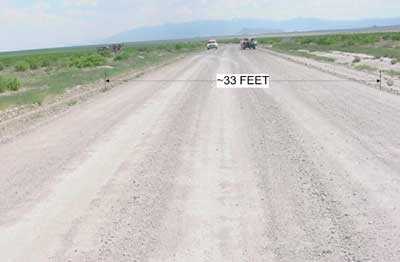
|
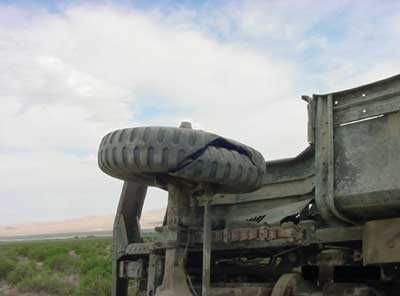
|
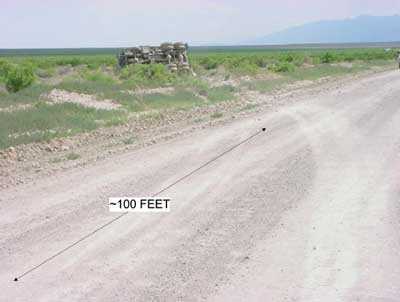
|
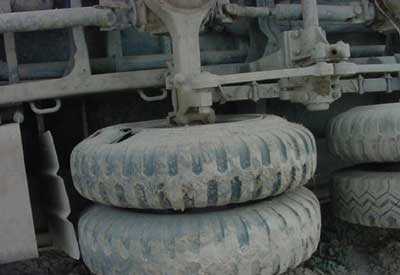
|
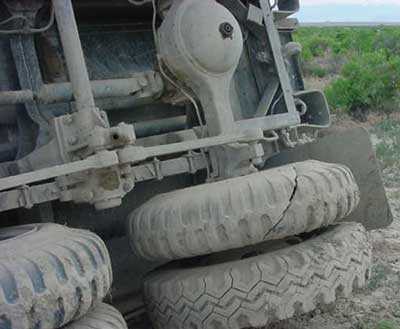
|
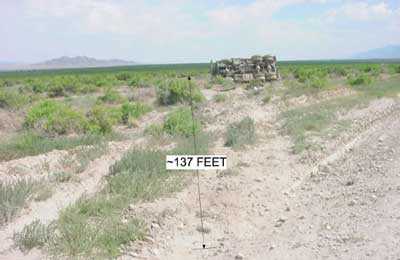
|
|
Photo 6. Distance from ditch to final resting place of vehicle which rolled more than 3 times. Photo courtesy of State forestry department. |
This page was last updated on 07/28/06.
- Page last reviewed: November 18, 2015
- Page last updated: October 15, 2014
- Content source:
- National Institute for Occupational Safety and Health Division of Safety Research


 ShareCompartir
ShareCompartir